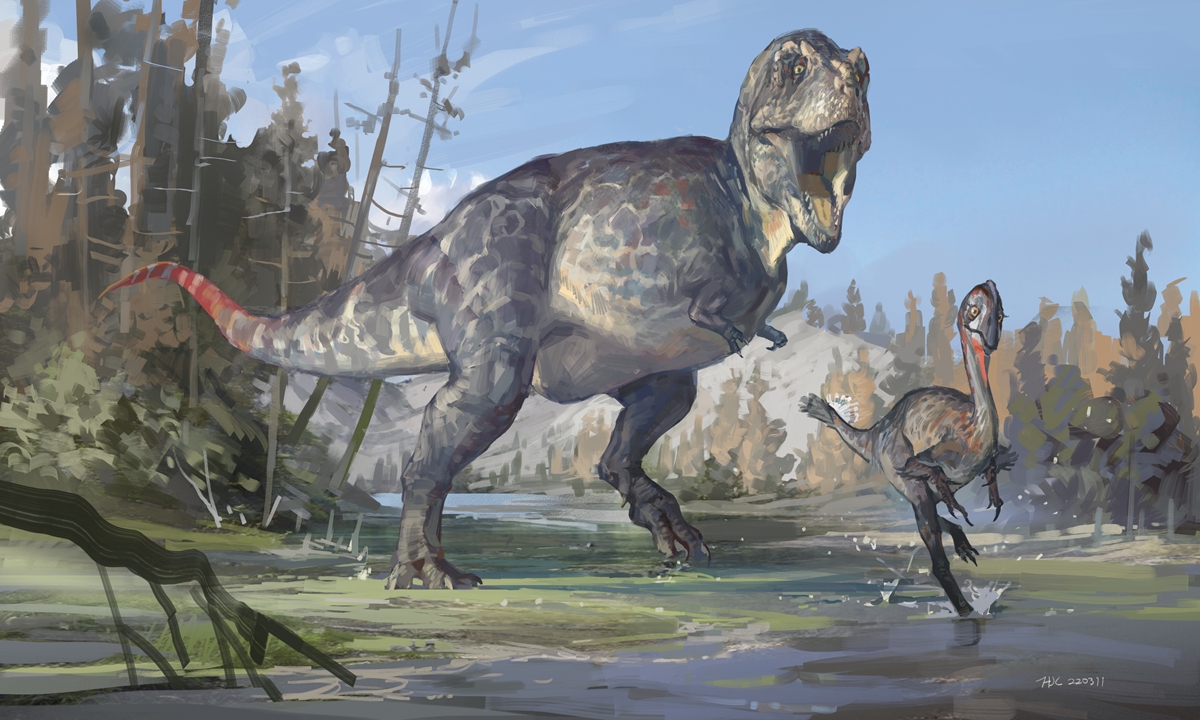
The restoration drawing of the tyrannosauroidea Photo: Courtesy of Huang Jiali
On Thursday morning, a group of Chinese researchers announced that they have identified the fossilized remains found in the Sanshui Basin in South China's Guangdong Province as belonging to tyrannosauroids. This marks the southernmost discovery of tyrannosauroid fossils in China to date.
The discovered fossils include four teeth dating back to the Maastrichtian stage of the Late Cretaceous, approximately 70 million to 66 million years ago. Three relatively intact teeth were found in the city of Sihui, each over 6 centimeters long, while a 3.3-centimeter fragment was uncovered in Guangzhou, capital of Guangdong.
These teeth exhibit consistent morphological features characteristic of tyrannosauroids, such as serrated edges, chisel-shaped serrations with interdental grooves, and the specific curvature of the carinae.
Besides this, systematic phylogenetic analyses also support their classification within the Tyrannosauroidea superfamily.
The findings have been published in the international journal Cretaceous Research, under the title "Large theropod teeth from the Upper Cretaceous of Guangdong Province, South China."
"These teeth constitute the first record of large theropods in southern Guangdong and are also the southernmost record of tyrannosauroids in China," said the paper.
Tyrannosauroidea is a group of predatory theropod dinosaurs with significant size variations that dominated the Middle to Late Cretaceous period. Tyrannosaurus rex, which lived in the Late Cretaceous and could exceed 12 meters in length, is the largest and most famous member of this group. However, there are also smaller species like the Early Cretaceous Dilong paradoxus, which was only about 1.5 meters long, Xing Lida, an associate professor at the China University of Geosciences, Beijing, and also one of the authors of the paper, told the Global Times on Thursday. Tyrannosauroid teeth exhibit heterodonty, meaning the size and shape of the teeth vary depending on their position in the mouth. Due to the incomplete nature of the fossils, precise identification of the teeth's position in the jaws remains undetermined, making the team unable to estimate the dinosaurs' overall size.
Wang Donghao, a doctoral student at China University of Geosciences, Beijing, and lead author of the study, estimated the specimens found in Sihui belong to a 5- to 6-meter-long individual, with the tooth found in Guangzhou suggesting a potentially larger creature.
Southern China lacked records of large theropods from the Late Cretaceous period before this discovery. Previously, tyrannosauroids such as Qianzhousaurus and tyrannosaur footprints were only discovered in Ganzhou, East China's Jiangxi Province, along with tyrannosaur teeth in Heyuan, Guangdong.
Dinosaur egg fossils from the Late Cretaceous period found in the Sanshui Basin indicate the presence of troodons, oviraptors and hadrosaurs. The newly discovered tyrannosauroid teeth, alongside these fossils, form a dinosaur assemblage, suggesting that dinosaur communities in southern China were likely still thriving just before the mass extinction at the end of the Cretaceous period.

One of the fossiled teeth found in the Sanshui Basin in South China's Guangdong Province Photo:Xing Lida
URL: https://www.seeglobalnews.com/read-3648.html